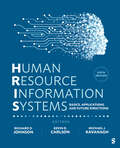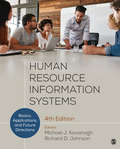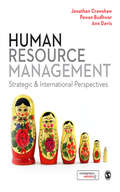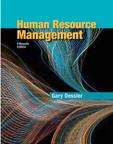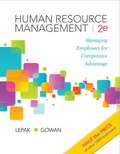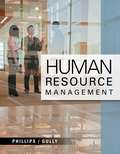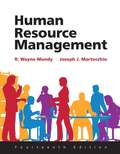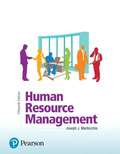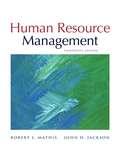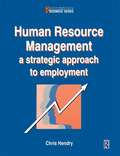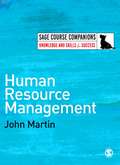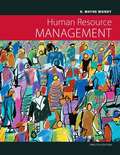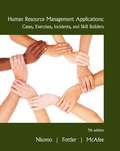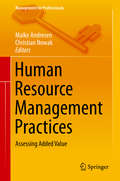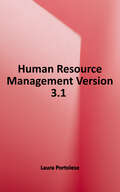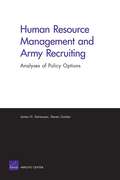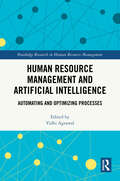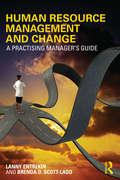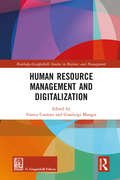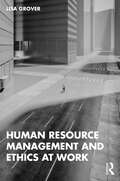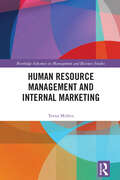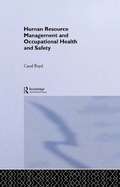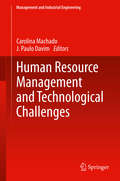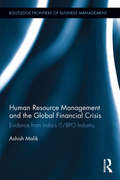- Table View
- List View
Human Resource Information Systems: Basics, Applications, and Future Directions
by Kevin D. Carlson Michael J. Kavanagh Richard David JohnsonHuman Resource Information Systems: Basics, Applications, and Future Directions is a one-of-a-kind book that provides a thorough introduction to the field of Human Resource Information Systems (HRIS) and shows how organizations today can leverage HRIS to make better people decisions and manage talent more effectively. Unlike other texts that overwhelm students with technical information and jargon, this revised Sixth Edition offers a balanced approach to dealing with HR issues and IT/IS issues by drawing from experts in both areas. Authors Richard D. Johnson, Kevin D. Carlson, and Michael J. Kavanagh cover the latest research and developments in information security, artificial intelligence, cloud computing, social media, and HR analytics. Numerous examples, best practices, discussion questions, and case studies, make this book the most student-friendly and current in the market.
Human Resource Information Systems: Basics, Applications, and Future Directions
by Richard Johnson Michael KavanaghHuman Resource Information Systems, edited by Michael J. Kavanagh and Richard D. Johnson, is a one-of-a-kind book that provides a thorough introduction to the field of Human Resource Information Systems (HRIS) and shows how organizations today can leverage HRIS to make better people decisions and manage talent more effectively. Unlike other texts that overwhelm students with technical information and jargon, this revised Fourth Edition offers a balanced approach in dealing with HR issues and IT/IS issues by drawing from experts in both areas. Numerous examples, best practices, discussion questions, and case studies make this the most student-friendly and current text on the market. New to This Edition A new chapter on social media explores how organizations can use social networks to recruit and select the best candidates. A new HRIS Expert feature spotlights real-world practitioners who share best practices and insights into how chapter concepts affect HR professions. New and expanded coverage of key trends such as information security, privacy, cloud computing, talent management software, and HR analytics is included.
Human Resource Management
by Dr Pawan Budhwar Jonathan Crawshaw Ann DavisThis new text treats international, strategic and contemporary issues as central to the study and practice of Human Resource Management. Covering the core curriculum, this book provides all the knowledge and tools you need to get the best possible grades and achieve career success after university. Key Features: Skills and employability focus will help you to develop the key transferable skills valued by graduate employers Debating HRM boxes encourage critical analysis and debate International and cross-cultural cases and discussion will prepare you for the global workplace Contemporary and strategic issues are introduced early on, underpinning the HRM functions Chapters on SMEs and the not-for-profit and voluntary sectors will ensure that your knowledge and skills can be applied in a range of organisational settings Mapped to the CIPD's learning outcomes but equally suitable for non-specialist students Journal articles, a glossary, podcasts and other resources are available on the book's website at www.sagepub.co.uk/crawshaw
Human Resource Management
by Gary DesslerFor courses in Management. Human Resource Management provides readers with the daily tools and skills they need to function as successful managers--in both human resources and business in general. With a practical approach, the text explores the evolution of the field, highlighting the introduction of revolutionary new technologies and social media platforms such as LinkedIn and cloud computing. The Fifteenth Edition focuses on the positive impacts technology has had on the HR field. The ability to vet potential employees on the Internet shifts more HR responsibilities to managers, leaving HR departments with more time to carry out strategic, long-term endeavors for boosting employee performance and engagement. With a heavy focus on emerging industry trends, the text prepares readers with everything they need to be successful managers and HR personnel in the 21st century.
Human Resource Management
by Gowan LepakThis book seeks to help students understand the dynamic and exciting environment of human resources (HR) management and the complex decisions that all managers must make when managing employees.
Human Resource Management
by Jean Phillips Stanley GullyThe focus of HUMAN RESOURCE MANAGEMENT is on developing students' personal and managerial skills by (1) Helping students understand the role of HR in organizational effectiveness as well as their personal career success; (2) Enabling students to understand how to flexibly apply the HR concepts that are appropriate for different problems or situations, and how HR both influences and is influenced by business strategy; and (3) Creating an understanding of the HR context by embedding the important concepts of ethics, diversity, competitive advantage, and the global context throughout the book. This highly readable book will help students understand how to use HR to hire, develop, motivate, and retain the right people and bring out the best in employees to execute the company's business strategy. It is intended for anyone who is or who might become a manager or an HR professional. By developing readers' competence and confidence in using important HR skills, this book will help anyone become a more effective manager through a better use of HR tools. Because most students learn more easily when they see the applicability of concepts to real life situations, HUMAN RESOURCE MANAGEMENT provides numerous current company examples throughout the book. A book-long integrated case supplemented with interactive online videos develops students' personal skills and gives them some experience in applying various HR concepts. The case and videos reinforce the relevance of the textbook material and make the content even more understandable.
Human Resource Management
by Joseph J. Martocchio R. Wayne MondyHuman Resource Management addresses the study of HR in a realistic, practical, and stimulating manner. Examples of how HR management is practiced in the real world and the relationship between various HR topics are interwoven throughout the text, giving students a thorough introduction to the field based on sound theoretical concepts and practice. The Fourteenth Edition reveals HR's strategic importance to management and the overall health of an organization. The text also addresses the ongoing shrinkage of internal HR departments as many companies shift towards HR outsourcing, HR shared service centers, and professional employer organizations. Students should walk away with an appreciation for how the HR profession continues to shed its administrative image and while focusing on mission-oriented activities.
Human Resource Management
by Joseph MartocchioFor students to succeed in a rapidly changing HR job market, knowledge of career options and skill development is key. Human Resource Management provides students with examples of how HR management is practiced in the real world and the relationships between various HR topics are interwoven throughout the text, giving a thorough introduction to the field based on sound theoretical concepts and practice.
Human Resource Management (13th Edition)
by Robert L. Mathis John H. JacksonTrust the authoritative resource for human resource management to offer the most current look at HR and its impact on today's organizations with both new and thoroughly updated cases and today's most recent examples--90 percent of which are from 2006 and beyond. Mathis/Jackson's HUMAN RESOURCE MANAGEMENT, Thirteenth Edition, is the most trusted resource and best-selling HR solution for preparing future or currently practicing HR professionals. Updated, strong academic coverage, including the latest 2009 HRCI outline, ensures this edition addresses all major topics for professional examinations (PHR, SPHR) given by the Human Resource Certification Institute (SHRM). The latest HR research and a wealth of new and proven learning features in every chapter demonstrate how HR impacts organizational strategy. Reorganized and streamlined topics examine emerging trends in technology, globalization, and HR Metrics, as well as other developments impacting the practice of HR today. A complete package of teaching and learning resources, including new CourseMate online learning tools, helps today's aspiring professionals prepare for career and future HR success.
Human Resource Management (B H Contemporary Business Ser.)
by Chris HendryThe majority of textbooks on HRM tend to focus on the administrative side of the subject and fail to examine its strategic importance. This book is intended to redress the balance and, taking strategy as its starting point, it looks at the overall roleof HRM in the organization. The author explores strategic human resource management through chapters on managing change in strategy, structure, and culture; the role of human resource planning, and types of employment system. He also reviews some of the key issues in managing different employee groups. These themes are problem- and issue- focused and extensively illustrated throughout with case study examples. Dr Chris Hendry is the author of many reports, research papers and articles on HRM and strategic management.
Human Resource Management (Fourteenth Edition)
by Robert L. Mathis John H. Jackson Sean R. ValentinePrepare for career and HR success with the best-selling text that has set the standard for excellence in human resource management. Mathis/Jackson's HUMAN RESOURCE MANAGEMENT, Fourteenth Edition, offers the most current look at HRM and its impact on the success of organizations today. Whether you are a practicing or future human resource management professional, or need to prepare for HR certification, this comprehensive market-leading text clearly introduces the latest HR research and unforgettable examples of HR in action that you need for success. A leading resource in preparing for professional HR certification, this edition provides solid readable coverage to ensure you address all major topics for the PHR and SPHR professional examinations given by the Human Resource Certification Institute (SHRM). The latest HR research and an effective blend of solid theory and contemporary practice highlight emerging trends driving change in HRM today, including technology, globalization, and HR metrics. The book's accompanying CourseMate online learning tools help you further achieve professional career and HR success. Trust the authoritative resource for human resource management to offer the most current look at HR and its impact on today's organizations. Mathis/Jackson's HUMAN RESOURCE MANAGEMENT, Fourteenth Edition, is the most trusted resource and best-selling HR solution for preparing future or currently practicing HR professionals.
Human Resource Management (SAGE Course Companions series)
by John L MartinThe SAGE Course Companion on Human Resource Management is an accessible introduction to the subject that will help readers to extend their understanding of key concepts and enhance their thinking skills in line with course requirements. It provides support on how to revise for exams and prepare for and write assessed pieces. Readers are encouraged not only to think like an HRM student but also to think about the subject critically. Designed to compliment existing textbooks for the course, the companion provides: - Easy access to the key themes in HRM - Helpful summaries of the approach taken by the main course textbooks and their strengths and weaknesses - Guidance on the essential study skills required to pass the course - Sample exam questions and answers, with advice on common themes that must always be addressed, how to use information effectively and pitfalls to advoid - Themes that run throughout the major points covered by the book - Taking it Further sections that suggest how readers can extent their thinking beyond the `received wisdom′ Much more than a revision guide for undergraduates, it is an essential tool that will help readers take their course understanding to new levels and help them achieve success in their undergraduate course.
Human Resource Management (Twelfth Edition)
by R. Wayne Mondy Judy Bandy MondyThere is no greater asset to a company than its employees—which is why Human Resource Management shows readers how to maximize a firm’s potential through identifying and keeping an ideal workforce. The twelfth edition addresses the changes in HR that have happened since the 2008 recession, as well as the expansive growth of social media. Over 900 new sources went into the development of this edition.
Human Resource Management Applications
by Stella M. Nkomo Myron D. Fottler R. Bruce McafeeStrengthen your practical understanding of today's human resource management (HRM) with this single source for actual cases, unique exercises and skill builders. HUMAN RESOURCE MANAGEMENT APPLICATIONS: CASES, EXERCISES, AND SKILL BUILDERS, 7E focuses on the abilities most important in HRM today with timely new cases and applications drawn from a variety of real organizations, including those in today's growing service sector. Learn to effectively handle some of today's controversial issues, such as environmentally friendly HR policies, the use of social networking, and same-sex benefits. This book perfectly complements your study of introductory human resource management with brief, yet powerful, exercises and a comprehensive project that helps you refine the skills most important for success in any HRM or business career.
Human Resource Management Practices
by Maike Andresen Christian NowakThis book is designed to help practitioners and academics to assess the added value of HR practices. It provides hands-on recommendations for choosing effective means to manage HR and specific suggestions aimed at facilitating the measurement of HR practices' impact on value creation. Evidence-based recommendations are made by drawing on thorough empirical research from various research traditions and academic disciplines. It covers a wide variety of tasks faced by the HR function and specifically addresses new challenges such as assessing the added value of work-life balance practices.
Human Resource Management Version 3.1
by Laura PortoleseThis textbook includes Online Access, Quizzes, Flashcards and Homework (if professor uses Homework system). Human Resource Management is structured to provide the necessary academic background information about managing people resources while also lending valuable insights from a practitioner’s perspective that encompasses both large and small businesses.
Human Resource Management and Army Recruiting
by Steven Garber James N. DertouzosU.S. Army Recruiting Command is faced with the challenge of ensuring that the flow of qualified volunteers is adequate to meet future active-duty accession requirements. This report documents research methods, findings, and policy conclusions from a project analyzing human resource management options for improving recruiting production. It details research designed to develop new insights to help guide future recruiter management policies.
Human Resource Management and Artificial Intelligence: Automating and Optimizing Processes (Routledge Research in Human Resource Management)
by Vidhi AgrawalThis edited volume undertakes an intellectual expedition aimed at elucidating the symbiotic relationship between Artificial Intelligence (AI) and the domain of Human Resource Management (HRM). Aligned with a forward-looking perspective, this scholarly work embarks on a comprehensive inquiry into the transformative capacities of AI within distinct HR functions, including but not limited to recruitment, performance evaluation, and employee development. As organizations embrace the transformative potential of AI, the book unfurls a roadmap that navigates the complexities of this transition. Insights into the metamorphosis of HRM practices, the recalibration of workforce dynamics, and the resultant organizational culture metamorphosis provide prescient guidance for stakeholders navigating the uncharted waters of AI adoption. Its overarching framework aspires to cultivate an environment conducive to intellectual discourse, offering a collaborative platform for academic scholars, research practitioners, industry experts, and policymakers to engage in the nuanced exploration of emergent AI-driven paradigms in HRM, organizational culture, and management of technology and innovation.
Human Resource Management and Change: A Practising Manager's Guide
by Lanny Entrekin Brenda D. Scott-LaddThis exciting new book has grown from a need to provide practical advice to managers who deal with contemporary human resource and change issues. A crucial role of a manager is to respond in the best interests of the organisation and at the same time retain talent. Skill shortages and ageing populations in developed economies and the need for emerging economies to develop their workforce coincide to present managers with unique challenges. Human Resource Management and Change: A practising managers guide offers a timely overview of recent environmental and economic changes as depicted by the DELTA forces of change. These include demographic, environmental, legal, technical and attitudinal changes that are in part the product of globalization, and the Global Financial Crisis (GFC). The fundamental strategies for managing change and implementing human resource practices are clearly explained. End of chapter study guides further explain the topics of the chapters by providing case studies and review and discussion questions as well as further reading. The text reflects the everyday challenge managers face in a turbulent environment and focuses on providing practical guidelines to managers who may not have higher academic qualifications to help them manage people and change.
Human Resource Management and Digitalization (Routledge-Giappichelli Studies in Business and Management)
by Franca Cantoni Gianluigi MangiaDigitalization is changing the world of work. Technology is shifting the relationship between workers and machines and how work is organized; new skills are becoming increasingly relevant in the workplace where workers no longer work for a single company, in 9-to-5 jobs, five days a week. Industry 4.0, also known as the Fourth Industrial Revolution, is revolutionizing the way managers can design, control and improve their activities. While the nature of the tasks and the interdependences between individuals are changing, the impact of intelligent technologies is severely questioning the span of control of leaders and the effectiveness of their leadership styles. The authors sketch out the main changes occurring in the business landscape and identify the new expectations that organizations are formulating for leaders across several industries. In an age in which new leadership models are about to emerge, they describe how the relevant changes impact and shape the managerial arena. This book sets the stage for a new way of thinking on the nature of the relationship between HR and technology. It examines the influence of Industry 4.0 and Innovation 4.0, (i.e. the connection between physical and digital processes in industrial production, where human competencies and machine potential are strictly interconnected throughout the entire value chain), from a myriad of viewpoints: namely in terms of structures, practices, influences (learning, training and communication), competencies and roles. A chapter is also dedicated to the understanding of the impact of Innovation 4.0, in the context of European Universities through E-learning Experiences where a multiple-case study analysis is provided.
Human Resource Management and Ethics at Work
by Lisa GroverHuman Resource Management and Ethics at Work dives deep into understanding ethical human resources practice, including professional codes of conduct and what it means to be an ethical human resources professional. Each chapter explores the philosophical underpinnings of the ethical challenges faced by contemporary human resources professionals. It draws upon narratives from fiction and film to bring these scenarios to life.Each chapter utilises theories and concepts from philosophy to equip current and aspiring human resources professionals to think about ethical issues. There are no right answers here, but by provoking debate and discussion, human resources professionals can make better choices. Through understanding and practice, we become ethical human resources professionals. The book is structured around the three ethical perspectives. First, the perspective of the individual human resources professional, focusing on good character and the traits of an ethical human resources professional. Second, the relationship between the individual human resources professional, the organisation and its employees, and human resources professional bodies. The human resources professional aims to have a positive impact on working lives but has to navigate a complex network of relationships and responsibilities. Third, the narrative moves to the macro level, identifying the social responsibilities of the human resources professional beyond their own organisation. A section of the book is dedicated to each of these pillars, exploring what they mean for the practising HR professional. Concepts and theories from philosophy are applied to understand this meaning. These tools can then be applied to novel situations that HR professionals go on to encounter in the workplace. Teaching activities are included throughout the book.This is an ideal resource for those undertaking an undergraduate or postgraduate course in human resource management, practising human resources professionals who worry about the right thing to do, or anyone interested in people management ethics.
Human Resource Management and Internal Marketing (Routledge Advances in Management and Business Studies)
by Teena MishraThis book explains various key concepts of internal marketing and its relation to human resource management, commitment, service quality, market orientation, etc. Various human resource models are insufficient to define internal marketing. Therefore there is a need to focus on the models and key concepts of human resource management and internal marketing and in what way they contribute to organizational success. It involves motivation, internal market research, internal communication, internal segmentation, employee retention, inter-functional coordination, and internal branding. The current need for human resource management is to link human resource management and marketing practices which are called internal marketing. Internal marketing plays an eminent role in organizational success. This book helps students, practitioners, start-ups, and educationists. This is a research monograph that will assist an organization to decide the future of human resource management as well as organizational development. This book is for marketing as well as human resource discipline. As internal marketing is the integration of marketing and human resource management. Due to new technology, globalization, and liberalization market need and demand are also changing, thus it is necessary to understand new trends in the application of human resources. Therefore, it is necessary to motivate and satisfy internal customers and make them market and skill-oriented.
Human Resource Management and Occupational Health and Safety (Routledge Advances in Management and Business Studies #No.26)
by Carol BoydOccupational Health and Safety (OHS) is a complex area which interacts widely with a broader spectrum of business interests and concerns. To date OHS has been confined to the periphery of Human Resource Management (HRM), where its role, influence and importance have been overlooked. This text sets out to reposition OHS in HRM and business agendas. This book unravels the complex range of factors affecting OHS policy, practice and outcomes. These factors are then placed into context within the international airline, call centre and nuclear power industries. The author presents a wide range of primary and secondary research in order to offer an accessible framework for OHS in contemporary occupational settings.This book will be essential reading for students, practitioners and professional academic audiences who seek a broader understanding of the relationship and interaction between HRM principles, policies and practices and OHS.
Human Resource Management and Technological Challenges
by J. Paulo Davim Carolina MachadoThis book focuses on the challenges and changes that new technologies bring to human resources (HR) of modern organizations. It examines the technological implications of the last changes taking place and how they affect the management and motivation of human resources belonging to these organizations. It looks for ways to understand and perceive how organizational HR, individually and as a team, conceptualize, invent, adapt, define and use organizational technology, as well as how they are constrained by features of it. The book provides discussion and the exchange of information on principles, strategies, models, techniques, methodologies and applications of human resources management and technological challenges and changes in the field of industry, commerce and services.
Human Resource Management and the Global Financial Crisis: Evidence from India's IT/BPO Industry (Routledge Frontiers of Business Management)
by Ashish MalikThis book analyses managerial responses and people management strategies and processes adopted to deal with the challenges imposed by the Global Financial Crisis (GFC). It examines how key actors in the system exercised strategic choices in a given strategic environment, as well as how they responded and developed strategies in this globally integrated industry, in an emerging market context. The book focuses on the nature of strategic choices available to firms in the Indian information technology (IT) and knowledge and business process outsourcing (K and BPO) industry. It looks at how these Indian firms in the IT industry exercise their strategic choices to deal with their routine business and how these routines were changed through learning and investment in certain HR and management practices in times of crisis. Additional insights from other national and industry contexts are also provided for wider coverage of how the GFC-affected organisations frame their responses to deal with it. The book examines the changes in the human resource processes and how organisations adjust their operant business models to deal with the pressures brought about by the crisis.
